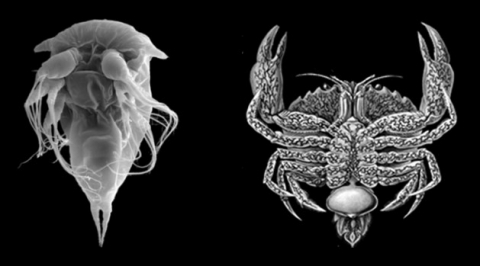
Soutenance de thèse de :
Fabien Trédez : "Originalités du développement larvaire de la sacculine (Sacculina carcini), parasite du crabe vert (Carcinus maenas)"
Vendredi 23 octobre à 10h
Auditorium de la Grande Galerie de l'Evolution, Jardin des Plantes, Paris
Le jury sera composé de :
- Sarah Bonnet, Directrice de recherche, INRA, Ecole vétérinaire de Maisons-Alfort, Rapporteur
- Jérôme Depaquit, Professeur à l’Université de Reims Champagne-Ardenne, Rapporteur
- Nadia Améziane, Professeur au Muséum national d’Histoire naturelle, Concarneau, Examinatrice
- Jean-Michel Gibert, Chargé de Recherche, CNRS, Institut de Biologie Paris-Seine, Paris, Examinateur
- Fabienne Audebert, Maître de conférences, Université Pierre et Marie Curie, Paris, Directrice de Thèse
- Nicolas Rabet, Maître de conférences, Université Pierre et Marie Curie, Paris, Directeur de Thèse.
Résumé de la thèse :
Originalités du développement larvaire de la sacculine (Sacculina carcini), parasite du crabe vert (Carcinus maenas)
Because of different lifestyles, the morpho-anatomy varies enormously among cirripeds. For instance, Sacculina carcini Thompson, 1836 (Crustacea: Thecostraca: Cirripedia: Rhizocephala) is a parasite of the green crab Carcinus maenas (Linné, 1758) and displays a highly simplified morphology, which may be interpreted as an adaptation to parasitism. S. carcini larvae (nauplius and cypris) are however similar to those of other, non-parasitic cirripeds. Morpho-anatomic comparison between parasitic and non-parasitic cirripeds is for this reason much easier between larvae. For the first time, the naupliar development of S. carcini has been closely studied by sampling larvae every four hours. This study resulted into the description of a previously overlooked naupliar stage, increasing the total number to five stages. In addition, it has been shown that the rate of larval development is similar within a single brood and between broods from different specimens. The description of a synchronous larval ontogenesis is new knowledge and it enables an accurate and continuous study of larval development; S. carcini naupliar development occurs within a cuticle sheath formed by the early detachment of the cuticle, before the ecdysis of the old cuticle. The thoracic development was studied after removal of this cuticle sheath. The thorax was shown to develop in four successive steps: initial cell proliferation, segmentation and individualization and differentiation of the appendages. Each of these steps occurs synchronously on the whole thorax and this type of synchronous development of the thorax has never been described in any crustacean larva. These results combined with data from the literature suggest that the synchronous development between larvae may be related to the shift to parasitism. Synchronous ontogenesis of the thorax is a derived character of all cirriped larvae, whereas the sub-cuticular development may be a synapomorphy of all thecostracans.
This study on S. carcini brought to light a new type of larval development, different to that known for other crustaceans. It would be particularly interesting to research these ontogenetic specificities in other crustacean taxa.
